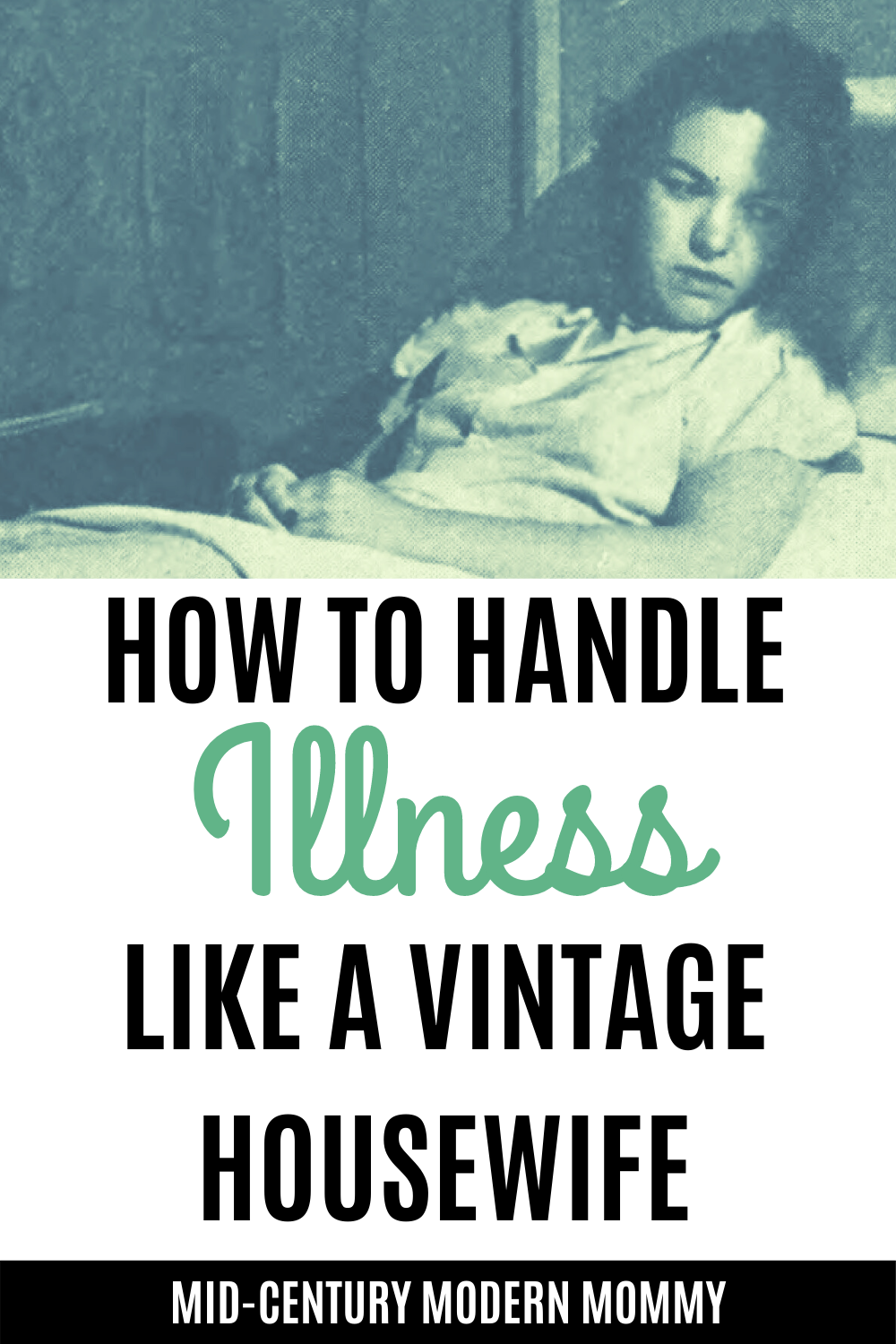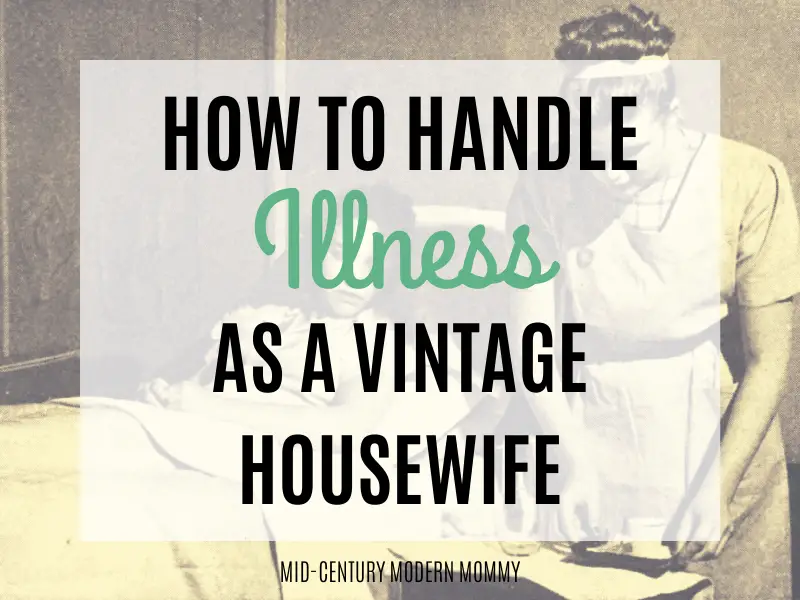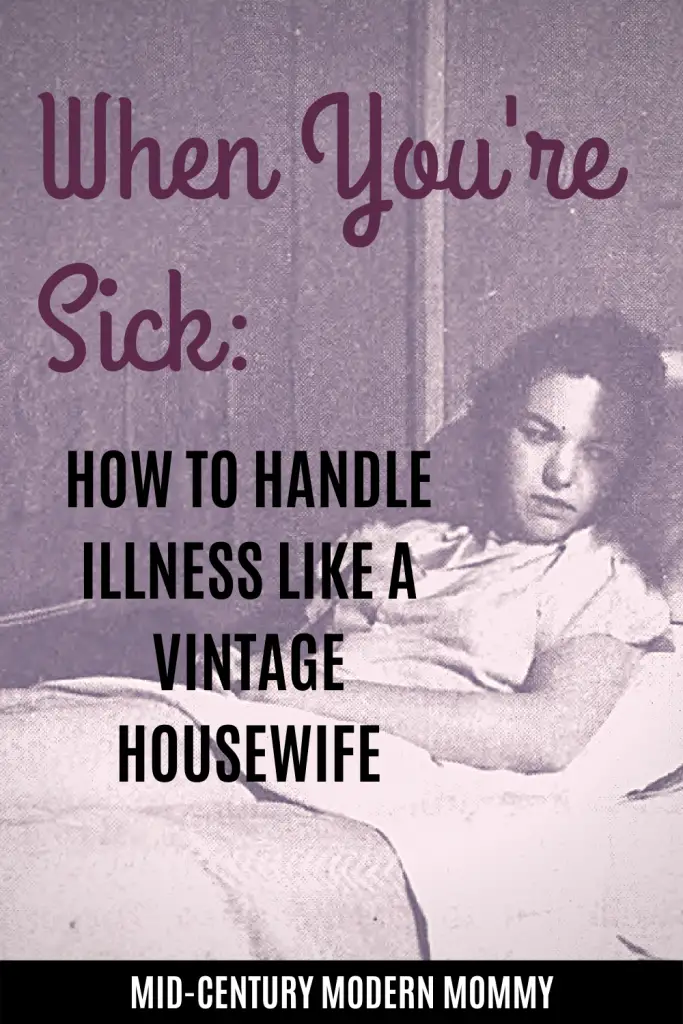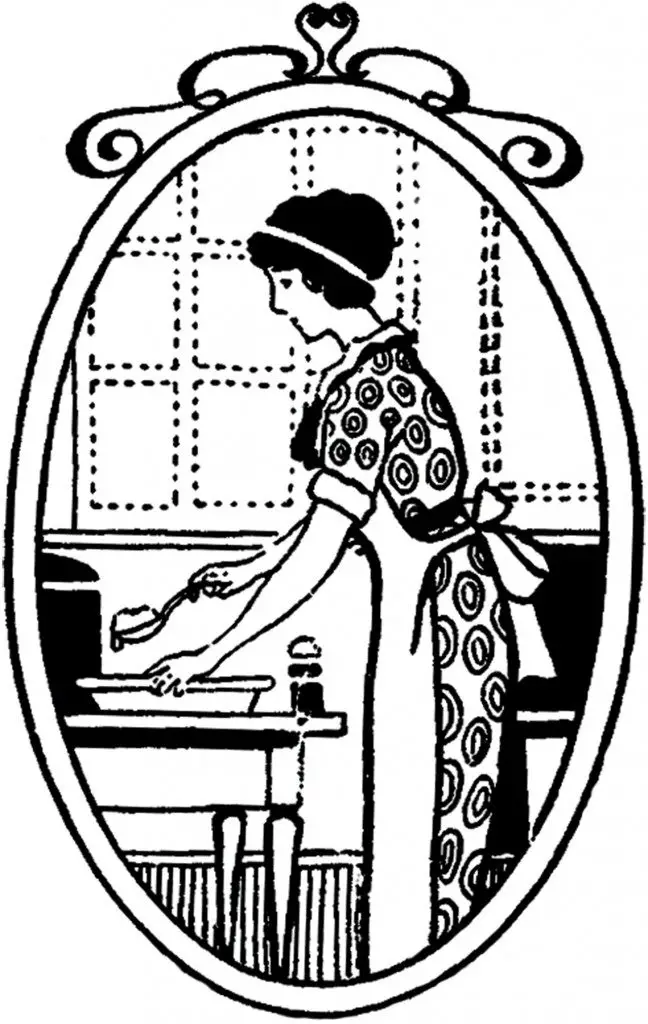This seems like a problem that comes up regularly during the flu season! How did the vintage housewife handle getting sick? Did she try to stay pretty? Did she keep the house clean? And how did she treat herself at home? So, to answer some of these questions, here’s how the 1950s housewife was told to handle illness. (Of course, it’s a lot easier to be graceful when your doctor can prescribe a codeine and morphine mixture to treat cold symptoms–I believe the term serene repose would adequately describe your drugged state at that point!)
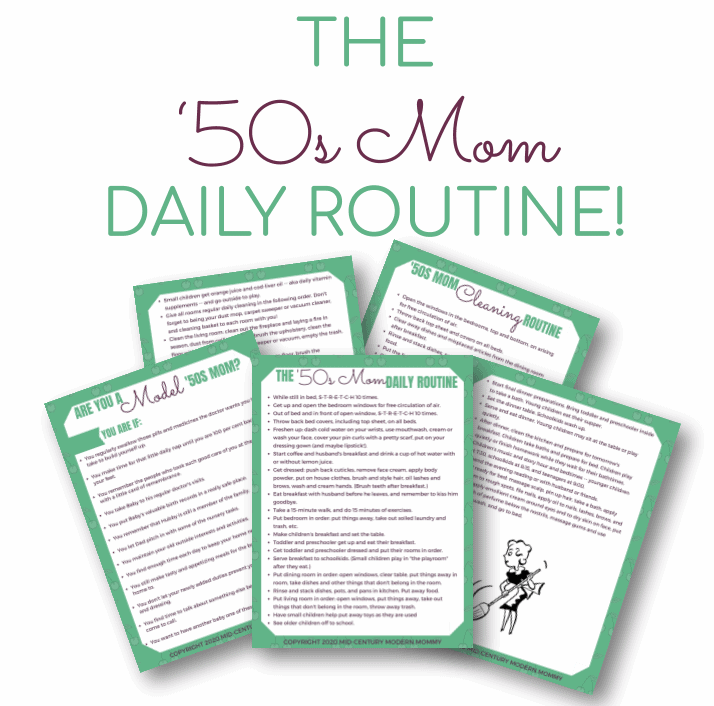
Get Our Mid-Century Mom Daily Routine FREE!
Respiratory Diseases
This post contains affiliate links. If you click a link and make a purchase, I may receive, at no additional cost to you, a small commission. Find out more on my Disclosures page, and thank you so much for your support!
Experts advised that a plan of bed rest while feverish was best. In practice, only children were required (by their mothers!) to stay in bed when they had a cold.
A sponge bath was used if the skin was uncomfortable from the fever, and brisk rubbing-down with the towel afterward was thought to be especially good in the case of a cold.
A uniquely mid-century recommendation was that in the case of sluggish bowels during a respiratory infection, the patient should use either an enema or a laxative to clear them. (Please ask your doctor before you try this suggestion!)
Patients were advised to eat a nourishing, appetizing, enjoyable diet while ill. Since the appetite was often lost, sugar and fruit juices were used to encourage patients to eat.
Home Remedies
The home remedies that were considered most helpful for cold were mustard foot baths, sweating it out with hot blankets and hot water bottles (affiliate link), and hot lemonade or orange juice. Aspirin was also recommended, but nowadays, please talk to your doctor about what fever reducer is recommended before taking anything!
Preparations of oil, camphor, menthol, and eucalyptus bring relief and comfort when the nose and lungs are irritated (I use Vapo-Rub (affiliate link)). A mustard poultice also helps with chest congestion.
Also, a patient with a cold was advised to drink 6 oz. of hot lemonade, orange juice or water every hour. And experts also recommended adding the tiniest bit of baking soda to the water to make it alkaline, since colds were thought to flourish in acidity.
Complications
Complications from infected ears were commonplace, and patients were advised to use care in blowing the nose, so as not to force the infection from the sinuses to the eustachian tubes in the ears.
Bronchitis and pneumonia were serious concerns for secondary infections, also. Back in the 1940s and 1950s pneumonia and flu were leading causes of death.
Pneumonia
Pneumonia, then as now, was a most serious acute disease. It regularly appeared as a complication of colds and flu, especially in winter and after exposure to cold or wet. Crowds were another common factor.
Proper care and nursing were considered essential in cases of pneumonia, and the patient was always treated as acutely ill, which meant bed rest and isolation.
Other Acute Illness
Most other acute illnesses, such as stomach flu and measles, were treated the same way as acute respiratory illnesses–with bed rest, isolation, and judicious use of home remedies to provide comfort. Proper nursing care and treatment by a physician were considered essential, lest complications ensue.
Even now, it’s a good idea to consult your doctor when you are sick. Vintage home remedies can help with comfort and regaining health, but a doctor can help prevent life-threatening complications!
Another recommendation was a liquid or semi-soft diet during acute cases, and nourishing, solid food during convalescence.
Chronic Illness
In cases of chronic illness, such as rheumatism (all forms of inflammation, including arthritis) or heart disease, the patient was considered mildly convalescent, a description which also applied after childbirth.
The mildly convalescent housewife was not required to stay in bed and was allowed to do her housework, but she was expected to curtail outside activities and rest or nap, with her feet up twice a day. She was also watched carefully to ensure that her infirmity did not become acute. Experts also recommended that she hire out as much of the heavy cleaning and laundry as possible so that she could regain her strength.
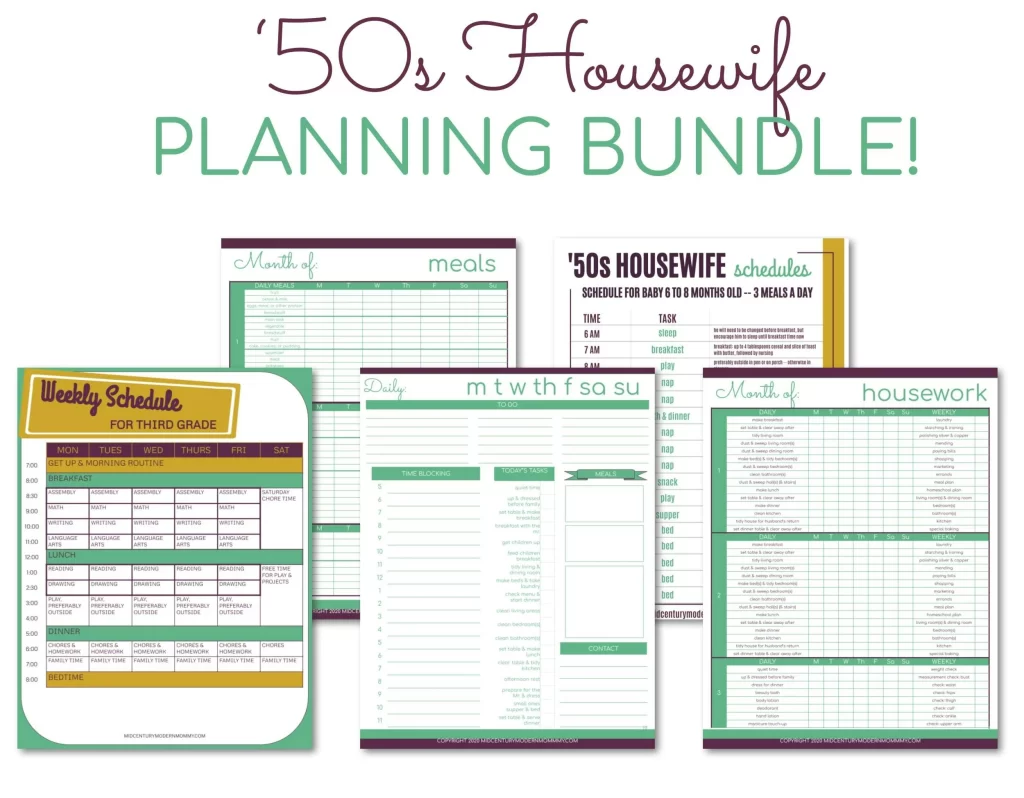
Bed rest for the housewife
In the 1930s, 1940s, and 1950s, mothers who had to be on bed rest either received help from their neighbors or hired practical nurses to help with the housekeeping and child care. If you couldn’t afford a nurse, then you’d better hope you hadn’t offended your neighbors!
I can’t afford a nurse. I also don’t have any helpful neighbors. So here’s how I handle being sick as a vintage housewife:
On Bedrest
When I am acutely sick, I wrap up in a blanket, recline on the living room couch, and make all the children stay in the room where I can see them. Sometimes, I let them watch TV, but most of the time, I just make them do their usual schoolwork or play together on the floor. Oh, and I nap when they nap.
I don’t have a dishwasher, so I pull out soup makings from the freezer, make big pots of soup, and serve in as few dishes as possible. I limit myself to taking care of the cooking and dishes, making the beds, and wiping down the bathroom while I bathe the children. Sometimes, when I’m really sick, those things take me all day!
If you have older children, you can sit (or lie!) in one spot and tell them things you see that need to be cleaned, assigning your chores as befits their ages and abilities. I firmly believe in requiring ALL my children to learn ALL the housekeeping chores. Practice, practice!
Mildly Convalescent
When I am mildly convalescent, I add essential laundry and keeping the dirt swept up to my minimum. I count the last two months of pregnancy and the first six weeks postpartum as mildly convalescent, as well (and longer, with complications!). I also count days when I stay up all night with a sick child as mildly convalescent.
The only thing that allows this to work, especially with all littles, or a large family, is severely paring down the housework. Think serious minimalism. Put away almost all the toys and books temporarily. I leave out Duplos or Legos, some dolls and stuffed toys, and some art supplies. That’s it. Other than that, they have a handful of picture books, schoolbooks, and their imaginations.
I also put away all the knick-knacks, and leave the surfaces bare as much as possible. I go to one-pot meals like casseroles and soups (hot cereal for breakfast), and I usually switch to paper napkins and tissues, too.
In the pantry, I keep an emergency shelf of dry and canned goods that I can use in a pinch. My freezer has a few “emergency” supplies for soup or casserole meals.
I keep my family medicine chest stocked up with home remedies and doctor’s recommendations. Those are all things I try to have ready all the time so that I can rest as much as possible when I am ill or under stress.
Also, in addition to limiting toys and books, I limit clothes. The children and I all have capsule wardrobes. It really cuts down on the laundry!
Home Nursing
Of course, there is also the whole, wide world of nursing your children when they are sick at home! But home nursing is a whole ‘nother post. (One I think every mother and housewife needs to know about!)
I hope this helps some of you who try to get everything done, even when sick. I know I feel better when I have a system that keeps the house running until I can really get back to work!
If you find this post helpful, please pin it! Or share it with another mother who is ill. And feel better soon!
